4
Dec
Compared to twenty years ago when I started writing about food when ingredients like frikeh (or freekeh) and argan oil were known to only a few westerners, there are now less and less secret ingredients, or indeed cuisines. You would think that with diners’ enthusiasm for global dishes and ingredients there isn’t much left for chefs or keen cooks to discover. But there is. And this is what we did last month at Books for Cooks, when I and Nadya Saleh from the National Museum of Qatar‘s Food Forum together with the delightful and very talented Aisha al-Tamimi introduced a keen audience to Qatari dishes they were totally unfamiliar with. The two cooking demonstrations were led by Aisha and were part of Nour Festival and Qatar UK, the latter being a collaboration between Qatar and the UK to exchange cultural and art events while the former is an initiative by the London Borough of Kensington and Chelsea to showcase Middle Eastern art and culture.
The National Museum of Qatar is being built by Jean Nouvel and when it opens in two years from now, one part will be devoted to a Food Forum with a lecture theatre and demonstration kitchen that will have a food culture programme (which I am helping develop) showcasing first and foremost Qatari cuisine and culinary traditions and also food and cooking from around the Middle East. We seized the opportunity to have our first programme, within both Nour Festival and Qatar UK, with two cooking demonstrations by Aisha on consecutive evenings to introduce a small group of foodies and food professionals to the delights of Qatari food.
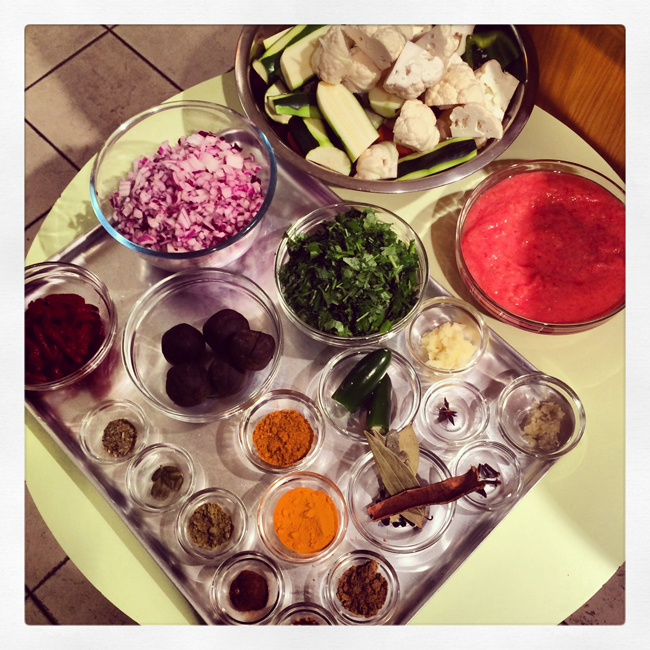 The interesting thing about Qatari cuisine is that it makes use of few unusual ingredients. It is true that some in the audience on both evenings asked what the dried black limes were but if I remember correctly it was the only ingredient that was unfamiliar to them. What they found intriguing on the other hand was how Aisha combined so many spices in the dishes she prepared. They also found some of the cooking techniques interesting.Take marguga for instance, a simple dish of chicken and vegetables cooked in a tomato sauce except that is is not so simple. In fact it was quite unlike anything I had eaten before when I first tasted it, cooked by Aisha’s sister, Maryam Abdallah who was the first Qatari TV chef. What makes it unusual is the bread (or strips of very thin dough if you want to stay with traditions) that is added at the end and cooked until it more or less melts in the sauce resulting in an incredibly luxurious dish with all the ingredients and flavours melding together to make each mouthful a mixture of velvety textures enhanced by the subtle dosing of the spices.
The interesting thing about Qatari cuisine is that it makes use of few unusual ingredients. It is true that some in the audience on both evenings asked what the dried black limes were but if I remember correctly it was the only ingredient that was unfamiliar to them. What they found intriguing on the other hand was how Aisha combined so many spices in the dishes she prepared. They also found some of the cooking techniques interesting.Take marguga for instance, a simple dish of chicken and vegetables cooked in a tomato sauce except that is is not so simple. In fact it was quite unlike anything I had eaten before when I first tasted it, cooked by Aisha’s sister, Maryam Abdallah who was the first Qatari TV chef. What makes it unusual is the bread (or strips of very thin dough if you want to stay with traditions) that is added at the end and cooked until it more or less melts in the sauce resulting in an incredibly luxurious dish with all the ingredients and flavours melding together to make each mouthful a mixture of velvety textures enhanced by the subtle dosing of the spices.
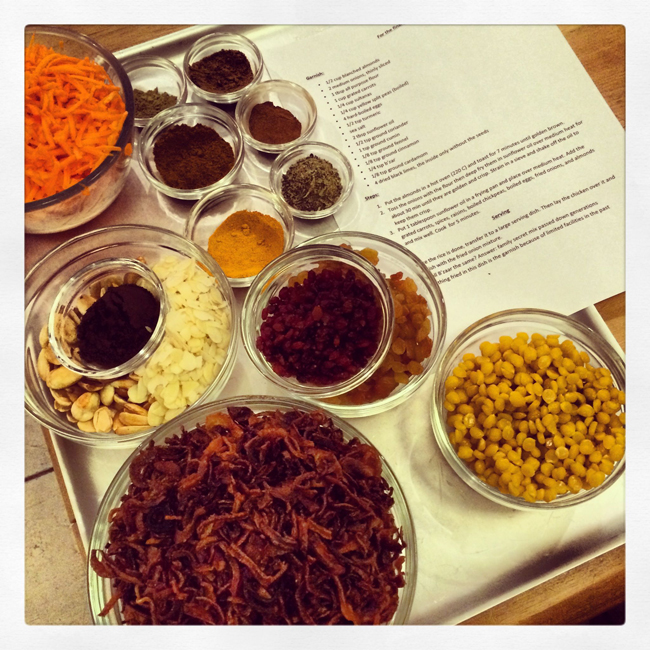 Another dish that Aisha demonstrated was mashbuss baddawi also known as mashbuss el-eid, a rice and meat dish served at special occasions (top picture). You find mashbuss throughout the Gulf. In some countries like Saudi Arabia, it is called kabsseh and of course each country has its own variation. What makes the Qatari version distinctive is how the chicken (or meat if the cook is using lamb or goat) is first boiled in the highly seasoned broth, then taken out and smeared with a tomato paste marinade before being cisped up in a hot oven. Then there is the rich garnish, a combination of caramelised onions, grated carrots, boiled split yellow peas, toasted nuts, golden raisins, boiled eggs and spices of course (you can see a picture for the garnish demo tray above), adding a rich dimension to the already richly seasoned rice and meat. The dish is quite stunning, both to look at and to eat. And everyone agreed on the evening, including the Qatari cultural attache and his supremely charming wife who both enjoyed the demonstration and the dinner that followed. All in all the programme was a great success and we look forward to more National Museum of Qatar’s Food Forum demonstrations, lectures and other events to introduce a wide audience to the rich culinary traditions of Qatar and the rest of the Middle East as well as North Africa. Below are a few more pictures from the Taste of Qatar evenings.
Another dish that Aisha demonstrated was mashbuss baddawi also known as mashbuss el-eid, a rice and meat dish served at special occasions (top picture). You find mashbuss throughout the Gulf. In some countries like Saudi Arabia, it is called kabsseh and of course each country has its own variation. What makes the Qatari version distinctive is how the chicken (or meat if the cook is using lamb or goat) is first boiled in the highly seasoned broth, then taken out and smeared with a tomato paste marinade before being cisped up in a hot oven. Then there is the rich garnish, a combination of caramelised onions, grated carrots, boiled split yellow peas, toasted nuts, golden raisins, boiled eggs and spices of course (you can see a picture for the garnish demo tray above), adding a rich dimension to the already richly seasoned rice and meat. The dish is quite stunning, both to look at and to eat. And everyone agreed on the evening, including the Qatari cultural attache and his supremely charming wife who both enjoyed the demonstration and the dinner that followed. All in all the programme was a great success and we look forward to more National Museum of Qatar’s Food Forum demonstrations, lectures and other events to introduce a wide audience to the rich culinary traditions of Qatar and the rest of the Middle East as well as North Africa. Below are a few more pictures from the Taste of Qatar evenings.
 Aisha being interviewed for a feature in al-Sharq al-Awsat
Aisha being interviewed for a feature in al-Sharq al-Awsat
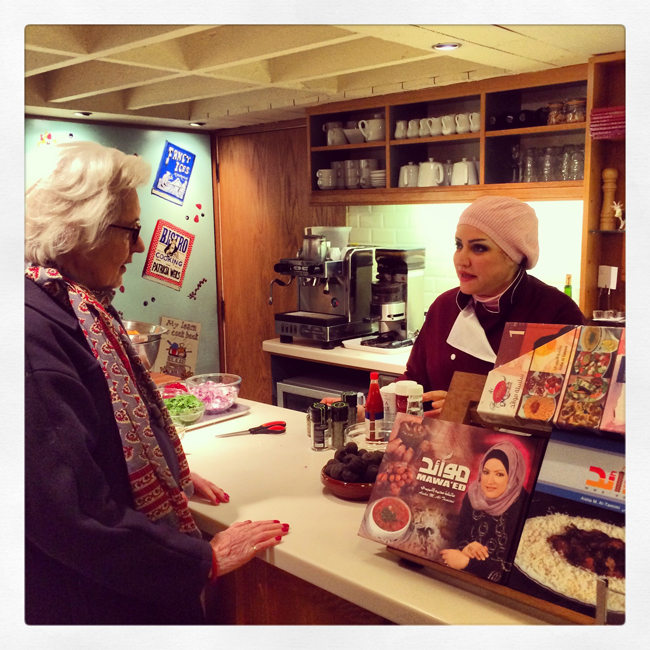 Arabella Boxer talking to Aisha on the first evening
Arabella Boxer talking to Aisha on the first evening
 The audience enjoying Aisha’s food
The audience enjoying Aisha’s food
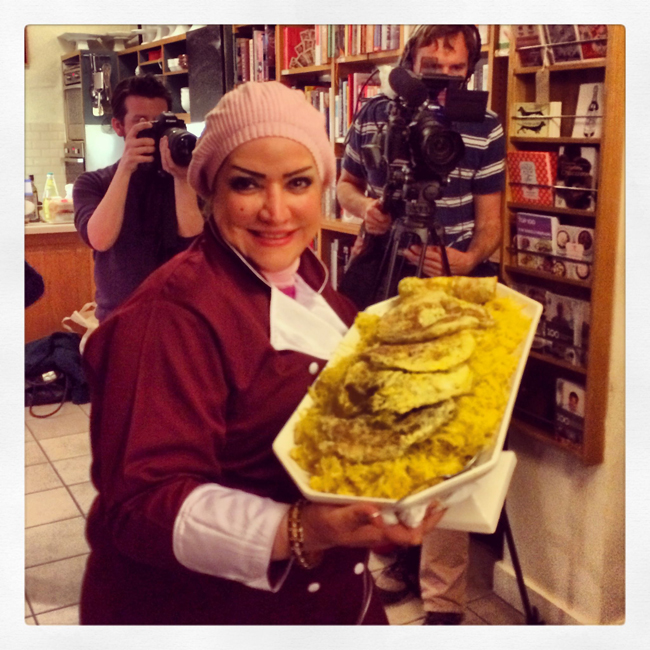 Aisha presenting balalit, a sweet-savoury vermicelli dish garnished with omelettes flavoured with cardamom and saffron and served for breakfast or when visitors come in between meals. Qatari hospitality is legendary and it is impossible for anyone to visit without the host or hostess offering Arabian coffee (post and recipe coming up), tea, cold drinks and various nibbles.
Aisha presenting balalit, a sweet-savoury vermicelli dish garnished with omelettes flavoured with cardamom and saffron and served for breakfast or when visitors come in between meals. Qatari hospitality is legendary and it is impossible for anyone to visit without the host or hostess offering Arabian coffee (post and recipe coming up), tea, cold drinks and various nibbles.
[youtube]http://www.youtube.com/watch?v=RdAadHJGfwg[/youtube]
And here is a video of the first night’s demonstration!
Tagged : aisha al-tamimi, arabella boxer, argan oil, books for cooks, dried black limes, eat qatar, food forum, freekeh, frikeh, marguga, maryam abdallah, mashbuss baddawi, national museum of qatar, nour festival, qatar, qatar uk, qatari cuisine, qatari culinary traditions, qatari food, secret ingredients, sheffield university ![]() 2
2

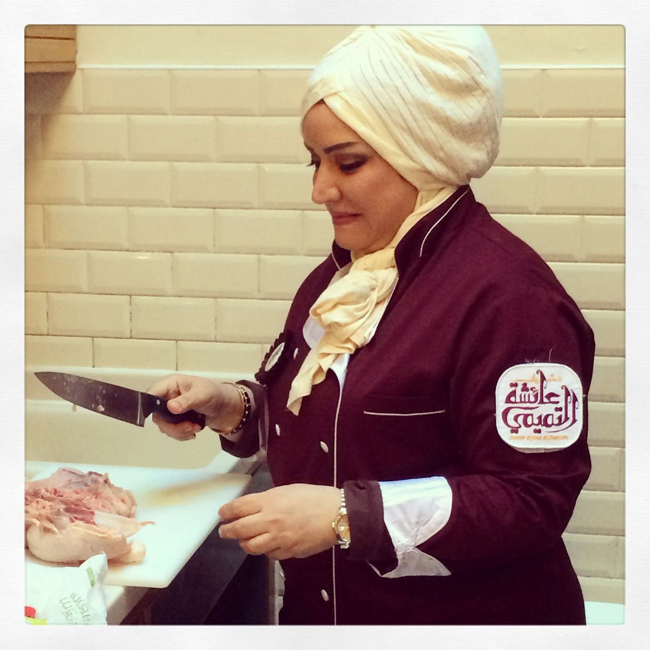
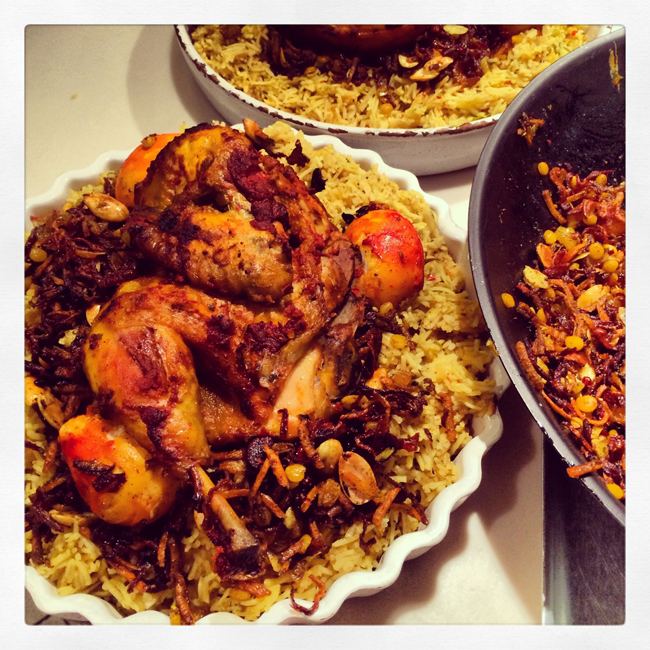

There is 2 comments on this post
Warning: Undefined array key 36 in /data/40/0/131/109/783598/user/802494/htdocs/anissahelou/wp-content/themes/Anissa/functions.php on line 377
March 27, 2016 at 4:17 am
Hi Anissa – I really enjoyed this blog. Me and my family are eating around the world alphabetically. We’re on Q and looking for a restaurant in London that does Qatar quisine. Do you have any recommendations?
Thx
Nick
Warning: Undefined array key 36 in /data/40/0/131/109/783598/user/802494/htdocs/anissahelou/wp-content/themes/Anissa/functions.php on line 377
March 27, 2016 at 4:47 am
i am afraid not. i think you sent me an email and i replied saying none. only thing to do is find a qatari friend 🙂